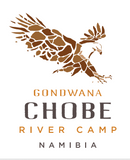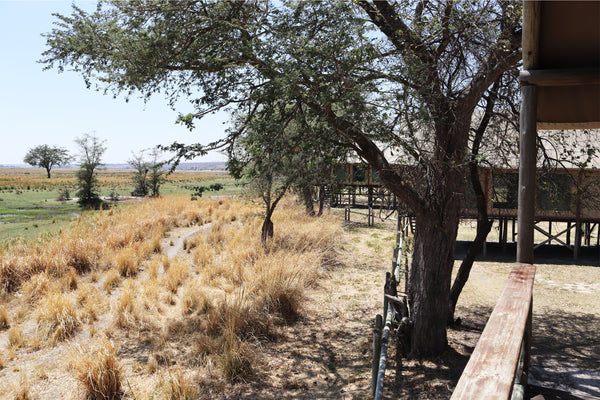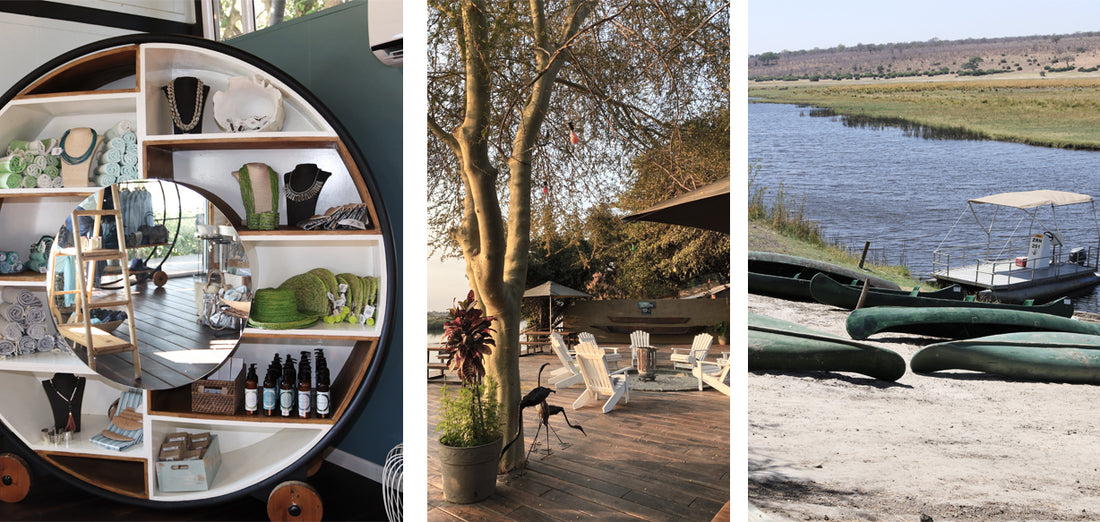Namibians have a special greeting where they use their hands folded into the shape of the country, using their thumbs to point out the area where Zambezi Mubala Lodge & Camp as well as Chobe River camp are located. Bordering Zambia and Botswana, you sure haven’t experienced true Namibia until you have visited this area!
The Zambezi region, although a thin and funny looking piece of land, packs a lot of history. Until late in the 19th century, the area was under firm control of the Lozi kings. The tribes consisted of the Lozi, Subia, Yei, Mafwe and Mbukushu. The Germans however wished to have a direct line from their territory on the East coast towards the West and were adamant to control this area. Leo von Caprivi was a German Chancellor who negotiated the land with the United Kingdom and exchanged it in 1890 for Zanzibar. The German colonial administration then founded their capital of the then known “Caprivi strip” in a small settlement first known as Luhonono, named after a prolific tree in this area, and renamed it Schuckmansburg, after the then Governor of Southwest Africa.

After Germany was stripped of its colonies after the end of the First World War in 1918 through the Treaty of Versailles, South Africa took over and moved the administrative centre to Katima Mulilo. Driving along this historical trajectory, a new highway has been built up from the ground to avoid getting flooded in the rainy season. Driving the 140 km distance from Namushasha to Mubala, we turn off at Kalimbeza where dense, high trees herald the arrival at Zambezi Mubala Camp.

Photo courtesy of Astrid van Lill
A canopy of indigenous trees pleasantly cools down the atmosphere and the sight of the sparkling blue water of the river does its magic on your mental state. A group of tented accommodation is strategically positioned, and the well-kept lawn gets you in instant holiday mode. The experienced camping & fishing fraternity of Namibia and South Africa have their favourite campsite booked way in advance and passes on this tradition from one generation to the next. The main area holds a very happy and creatively confused souvenir shop that guides the way to the sprawling wooden deck, bar, and boat dock. Directly in front, a small island with lush vegetation, seems to be an ecological haven for birds and crocodiles alike. This cozy, well established Camp used to be “Island View Camp” before it became part of the Gondwana family.

Photo courtesy of Sonia Noirfalise-Corsini
The Camp also forms the departure point for all guests staying at the Zambezi Mubala Lodge but it’s laid-back feeling entices many a guest to sit down for a chilled draught beer, burgers and/or pizza accompanied with a perfect river view. The shop holds an extensive range for avid fishermen caps with everything their heart possibly desires. If you made it this far with your children, they are sure to spot the colourful wire products. And seeing that you don’t want to drive to Katima Mulilo every day and look for Schnapps glasses to celebrate your first Tiger fish catch, Zambezi Mubala Camp provides wonderful exploration of all the quirky things scattered around. I am so excited to find a T-shirt with the very rare Schalow’s turaco , who the wonderful staff has no qualm to point out between the trees!

Embarking on the boats below, a sense of pioneer adventure becomes me.
Mark Twain once said: “In 20 years you will be more disappointed about the things you didn’t do, than the things you did. So, untie the knots, run out of your safe harbour, and catch the trade winds with your sails”.
Leisurely piloting the boat eastwards, I dreamily watch the seasonal mud huts of the cattle herders on promontories and see the extend of the floodplains of the mighty Zambezi. The 2574 km long river originates in Northern Zambia, flows through Angola, Namibia, Botswana
before cascading down the Victoria Falls (first discovered in 1855 by David Livingstone). It continues to earn its name by passing Mana Pools and Lake Kariba in Zimbabwe and Lake Cahora Bassa in Mozambique and despite these 2 serious dams built to create hydroelectric energy, it eventually reaches the East coast of Africa in the Indian ocean somewhere halfway North of Beira and South of Quelimane.

White throated swallows are happily joining in on the airy ride as they are protecting their nests which they build just under the roof of the boat. This area truly is Namibia’s best kept secret and those few connoisseurs in the know make sure to visit the area between February and April, as this time the flood plains are swollen and access to Zambezi Mubala Lodge is guaranteed by boat. Just before our arrival at Zambezi Mubala Lodge, I start to see the various holes in the sandy banks and one of the main reasons why I have this area on my bucket list: the yearly arrival of the Southern Carmine Bee eaters for the breeding season. Other Merops genus, commonly known as Bee-eaters compete for riverbank nests and shoot in and out from the nests whilst catching their favourite staple of bees, dragonflies and other insects’ midair for their offspring. Especially when there are agricultural clearing fires, it is a colourful spectacle not to be missed! Read the book Chariots of Fire to learn more.

Photo courtesy of Astrid van Lill
Zambezi Mubala Lodge appears like a designer water world paradise. We dock just below the open-air bar & lounge area and are greeted by the Giant kingfisher bobbing on the ropes of our boat. A monitor lizard beats a hasty retreat between the sandbags that protect the banks. Arriving at the top, a sparkling clean pool with inviting loungers and a green lawn determines my afternoon activity. We are being escorted to our room by a wooden walkway on stilts passing the beautiful open air dining area with a full view of the river. The superlight, innovative building structures are positioned in such a way that each guest has their own little perched dwelling. The interior of the room feels cool & bright and very spacious. The locally sculpted glass bead curtains, porthole windows and the reading chair with ottoman in front allude to relaxing, special me time in your private cabin. The 4-poster canopy bed is softly surrounded by mosquito curtains lined with green felt borders and forms a wonderfully dreamy island in the center of the bedroom. All textures and the free use of blues and greens in the bathroom translate to the environment outside and make showering with a view a true delight.

Photo courtesy of Astrid van Lill
Popping in at the reception building, these dreamy colours can be seen in my eyes and strengthened by the cooling waft of the air conditioners. All things Carmine bee-eaters are found, from ceramics to canvas prints and lovely bird print tableware. It is without a doubt necessary to support conservation efforts towards these birds as their existence is threatened daily by the increasing human/wildlife conflict. Because these beautiful birds have a habit of also breeding in mounds on the sand floor, cattle farming along the river endangers their procreation efforts, and more horrifically, increasing demand for their colourful feathers seriously endangers their survival. It is therefore that the brand essence “experience the colours of the river”, reflects on their conservation efforts.

I pick up a beautiful colouring book for keeping my hands busy at the poolside and love the gold embellished scarf and woven half-moon crochet bag to add to my sundowner boat trip later. The staff carefully wraps an incredibly beautiful green fluorite lamp which I am told was mined and created in Namibia for me to pack in the centre of my luggage to take home and relive these moments.

After a 2-night stay, I am rejuvenated and ready for the last stretch of my journey in the Zambezi region. It’s hard to believe that upon reaching Chobe River Camp, I will be 1270 km away from Windhoek! No wonder it feels like I have become a true explorer of Africa, our continent, collecting as many border stamps as possible. A visit to Chobe River Camp can
be super-hot, dry, and dusty from late August until November. The water gets less and less as it flows back into the Zambezi, causing the animals to be either far and few or right in front of your tent grazing on the island. Groups of waterbucks, impala, lechwe, and zebra graze alongside wildebeest and cattle during sunrise and sunset. The community along the road uses its oxen span to pull wooden mokoro loaded with water containers for long distances. Both humans and animals know how to conserve their energy during this scorching hot season, and by clockwork each evening, you can observe Botswana’s herds of elephants coming down the ridge on ancient pathways to drink at the waters ‘edge. The multitude of mighty baobabs along that ridge can be seen by the naked eye in otherwise dry surroundings.

Photo courtesy of Astrid van Lill
Whether dry or rainy season, the prolific birdlife in this area never disappoints. A magpie shrike has taken up residency in front of the main area and likes to scoop water from the adjacent swimming pool. If the regular boats cannot reach the further regions of the river temporarily, one can however still book a guided canoe trip for a photographic journey to spot and tick off a myriad of bird species along the banks. We heard the quintessential noise of African rivers and spotted the national bird of Namibia, the imposing African Fish Eagle perched up a tree branch. Open billed stork, grey heron & the red billed hoopoe come awfully close to a sizeable crocodile sunning on a sandbank. The pied kingfisher hoovers above the water zoning in on his prey below, whilst the African Jacana always is a sight to behold, how he seems to be able to walk on the water. To me, this is nature at its wildest and a sight to behold. The camps’ brand essence “sounds of the river” speaks for itself.

Photo courtesy of Astrid van Lill
The tiny shop in the main tented lounge will soon receive a designated and classic “simply safari” themed shop. Taking its cue from the position at the edge of the wilderness, it will stock practical travel necessities such as the awesome t-shirt design with matching Camp logo cap . Being this close to the border with Botswana, the intrepid explorers amongst you should not miss out on crossing the bridge over the Chobe and taking a day visit to drive through the Chobe National Park to Kasane. It is even possible to continue your day trip and obtain a second stamp in your passport and take in the sights of the majestic Victoria Falls at the town’s namesake in Zimbabwe! The energy and vibe are palpable in this region, and you will always remember this exciting safari adventure. With our neighbours’ high-end prices charged in Pula and US dollars, you will be very happy to return to Namibia’s much more feasible prices in our tourism industry. So much so, that your carefully curated gin tonic for sundowners will be enjoyed and followed by an affordable refill!

The moment the rainy season starts from December, Chobe is the most transformative area that I have ever witnessed in Namibia. The fine black cotton dust metamorphoses into sticky mud which takes skills to navigate in order not to get your vehicle stuck. Where once you would walk on the lawn towards the open plan main tent area that houses the bar with lounge, breakfast area and dinner boma, a true water world grows day by day. The Zig zag terminalia and the yellow fever trees are the only ones holding ground and pin a location that once was dry. The wooden walkways to the boat dock as well as the tents high on stilts should have given you a clear indication of what can be, and those funny pictures of housekeeping teams with baskets on their heads containing fresh linen moving between tents in mokoros are no marketing trick! The passing of herds of buffalo with white little egrets on their backs also brings the exciting sounds of lions roaring at night. These predators can be quite vocal, making you feel humble and apprehensive at night in your canvas tent on stilts!
Did you know that Botswana and Namibia share a massive migration of zebra? The herds start mass moving in December from Chobe National Park crossing the river and making their way to the salt pans in the Makgadikgadi National Park in the interior of the Kalahari Desert. From an apparently unassuming, dry, and dusty place, Chobe’s metamorphosis into
a lush, verdant green landscape teeming with wildlife is something that should be high on everybody’s bucket list. Chobe River Camp invites you to see the best of both worlds as a modern-day explorer.
Written by: Sonia Noirfalise-Corsini

